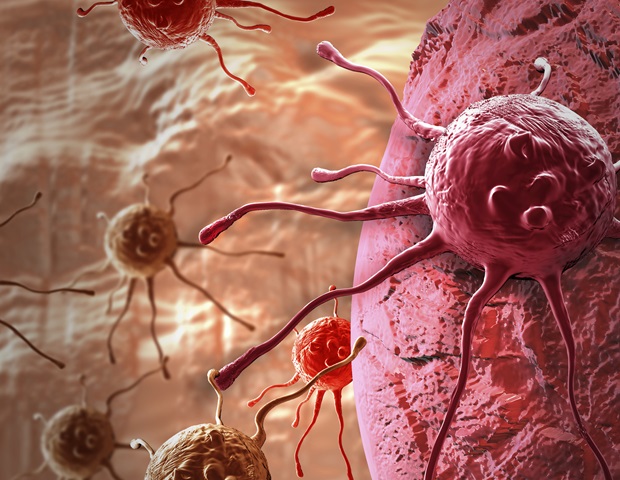European Cooperation in Science and Technology (COST) World Cancer Day aims at raising awareness of cancer and to encourage its prevention, detection, and treatment. Ten million people die each year from cancer. By 2030, experts project cancer deaths will reach thirteen million. More than one third of cancer cases can be prevented. Another third can be cured if detected early and treated properly.
Curing cancer is one of the major challenges for research and innovation in the years to come. COST has long been attracting research communities working on beating cancer through an interdisciplinary approach.
To mark the World Cancer Day, here is an overview of COST Actions that contribute to the fight against the disease.
European Research Network on Signal Transduction
All cells face the vital challenge of sensing their environments and responding in appropriate ways. This process is accomplished by transmembrane signal transduction, which is present in every species and governs every aspect of how an organism function. In regard to human health, there is a huge drive to understand how transmembrane signal transduction networks function on the molecular, cellular, and physiological level so that drugs can be designed to modulate different aspects of the signal transduction cascade in highly specific ways. Despite significant progress in understanding the individual components, signal transduction as a whole is not fully understood. The main scientific objective of the Action is to develop a common, comprehensive, and holistic map of signal transduction that will advance development of pathway-specific chemical modulators.
Functional Glyconanomaterials for the Development of Diagnostics and Targeted Therapeutic Probes
Carbohydrates, proteins, lipids, and nucleic acids are the biomacromolecules that constitute the fundamental building blocks of life. Among those, carbohydrates are key players involved in a myriad of molecular recognition events from protein folding, cell-cell communication, bacterial and viral infections to fertilization. Cell-surface carbohydrates can differ considerably between cell lines and also between healthy and disease states. These differences can be exploited for the development of early diagnostic tools, prevention and/or treatment of diseases via for example molecules/probes that target the interactions between key glycans and their receptors. The aim of this action is to bring together experts in these different areas from all around Europe to develop the next generation of functional glyconanomaterials for the development of diagnostic tools and targeted therapeutics.
International Nucleome Consortium
The genomic revolution has been a unidimensional one. Chromosome maps, sequences, polymorphism databases, the wealth of information that has been and continues to be gained from genomic studies exists independently of the cellular context. Yet our genome lives as a three-dimensional object intricately folded and packaged in the cell nucleus, structured around nuclear bodies and landmarks, acted upon by countless force-generating nano-machines. The field is now attracting more and more people with very diverse expertise (biologists, physicists, mathematician, statisticians, data scientists). The International Nucleome Consortium will establish a worldwide community of cooperation among multi-disciplinary nucleome scientists to accelerate scientific breakthroughs leading to new concepts, innovative interdisciplinary approaches and realistic applications for health, agriculture, and industry.
European Cholangiocarcinoma Network
Cholangiocarcinomas (CCAs) are a heterogeneous group of cancers of the biliary tree. CCA is considered one of the deadliest cancers and its incidence is increasing constantly and dramatically in Europe. Notably, CCA is the most frequent cause of cancer metastases of unknow origin, suggesting underestimation of the CCA problem. CCA heterogeneity has limited the discovery of biomarkers and novel therapeutic options, hampering the development of tools for early diagnosis and effective treatment. CCA constitutes a major challenge for researchers, clinicians, national health systems and society. Still, coordinated multidisciplinary pan-European studies are lacking. As such, the EURO-CHOLANGIO-NET (European Cholangiocarcinoma Network) aims to set up a pan-European-wide interdisciplinary co-operative network of stakeholders, including scientists, clinicians, regulatory authorities, small/medium enterprises (SMEs) and industry partners, to address the CCA problem.
European network for Gynecological Rare Cancer research: From Concept to Cure
Approximately 18.5 million women annually are affected by gynecological cancer, from which approximately 50% are classified as rare cancers. Delayed diagnosis of patients suffering from rare gynecological cancers leads to poor outcomes and contributes to a huge socio-economic burden. This field is lagging due to distinct scientific and technological challenges that gynecological cancer research faces. Currently, the overall efforts for addressing these challenges are fragmented across different European countries (and beyond).
GYNOCARE aims to address these challenges by creating a unique network between key stakeholders covering five distinct domains (from concept to cure): basic research on rare gynecological cancer, biobanking, industrial dimension, legal and regulatory requirements for international trials and other research collaborative efforts, and high-quality, international, and innovative clinical trials.
European Cooperation in Science and Technology (COST)
Posted in: Medical Condition News
Tags: Agriculture, Antisense, Assay, Biobanking, Biomarker, Biomonitoring, Cancer, Cell, Cell Nucleus, Cholangiocarcinoma, Chromosome, Colorectal, Colorectal Cancer, Comet Assay, Diagnostic, Diagnostics, Drug Discovery, Drugs, Electromagnetic, Fertilization, Gene, Genome, Genomic, Glycans, Health Systems, in vitro, Ligand, Lipids, Nanomedicine, Next Generation, Protein, Protein Folding, Pseudomyxoma Peritonei, Research, RNA, Therapeutics, Vaccine, Webinar
Source: Read Full Article
